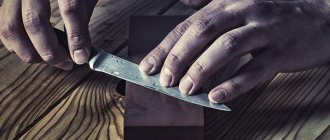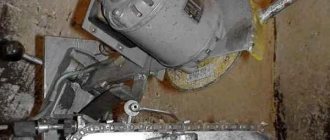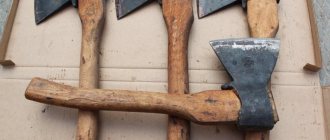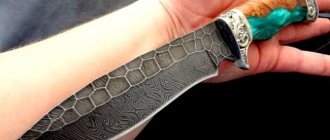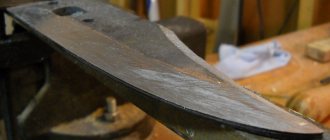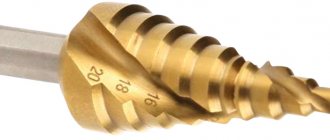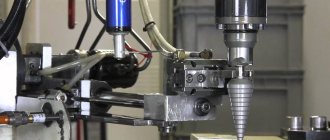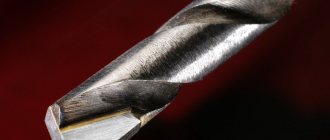Types of knives for electric planer
The tool has a rotating drum on which the cutting parts are fixed. The drum is secured with ordinary nuts. If you loosen them, it will be possible to remove the knives. Since the blade has two sharpening sides, if one of the sides becomes dull, the knife can be quickly turned over.
The industry produces several blades for such a tool . They differ in their design and shape:
- Direct. Planing of small workpieces. You can choose a quarter.
- Wavy. They imitate “aged” wood.
- Rounded. They are used for processing wide surfaces when it is necessary to make a neat shaped transition between planing planes.
Knives differ not only in their shape. Their size also plays a major role. There are several groups:
- Plates - 82x5.5x1.2 mm. They are used on foreign equipment such as Black&Deccer. Carbon steel is used to make the blade.
- Special knives. They differ from plates in their dimensions. They are much thicker and wider. Available in lengths of 82 or 102 mm. The large thickness makes it easier to sharpen the tool.
- Blades for a specific device. Typically the blade width does not exceed 110 mm. To secure the blade, special holes are provided.
Disposable knives
Knives intended for disposable use are made of steel-based hard alloys in the form of plates sharp on both sides. Such cutting parts cannot be sharpened. After the edge being used is completely worn out, the blade is turned over and placed on the drum with the other side. At the same time, the tool continues to work. If the second cutting edge becomes dull, then the blade is simply thrown away.
Disposable knives are intended only for performing work that does not require high precision and quality of workpiece processing. But they are convenient for practical use: during installation they do not need to be precisely adjusted and balanced.
The shapes of disposable products are:
- straight;
- wavy;
- straight, but rounded at the ends.
The first type of product has a straight cutting part. It is convenient to use such consumables to process parts that have a smaller width than the length of the installed blade, and to select quarters. Wavy knives are used when it is necessary to carry out rough processing of lumber. With their help, you can give a wooden surface a different texture, for example, to simulate “aging.” Straight cutting edges, rounded at the edges, are good because they do not leave marks (grooves, steps) on the surface of the wood being processed. This is a suitable option if you need to work with wide wooden pieces.
Disposable blades have a longer service life, but can break quite easily if they accidentally collide with metal (for example, a nail, bolt). They are the best option for attachments when it is necessary to work with hard wood workpieces.
Reusable cutting attachments
Products that are intended for reusable use differ in both their shape and size from disposable cutting attachments. They are made using high quality steel, which ensures ease and quality of processing of wooden surfaces.
Using reusable knives, you can achieve such a smooth surface of the workpiece that grinding is not required. They are marked HSS (fully High-Speed Steel, which translates as high-speed steel). These blades are considered professional. Their installation is accompanied by high-precision balancing and adjustment. The sharpening must also be of excellent quality. In this case, tool high-speed steel can be sharpened so that it is very sharp.
It is more profitable to buy reusable cutting attachments because they can be sharpened multiple times. But high-speed steel products do not allow processing hardwood (for example, larch or oak).
The working drums of most models of electric planes can be equipped with both disposable and reusable cutting attachments. But there are also devices that can only be equipped with blades that are not intended for sharpening. For this reason, when purchasing an electric planer, it is recommended to give preference to universal power tools.
Classification by size
Knives for electric planers can be standard or non-standard sizes. Products of the first type, called “plates,” have a length of 82 mm, a width of 5.5 mm, and a thickness of 1.2 mm. Such cutting attachments are suitable for most models of electric planes from foreign companies Makita, Skil, Bosch, Black&Dekker.
Straight knives for electric planers Bosch, SKIL
Non-standard cutting attachments with larger blade widths and thicknesses are typical for electric planers from Baikal and Interskol. Due to their parameters, they are stronger and better than standard plates. When they come into contact with metal, such knives do not break. They can be sharpened using sandpaper. The width of the nozzles is about 1 cm. The length can be 82 mm, 102 mm, and for products from the Rebir company it reaches 110 mm.
Straight knives for electric planer Rebir IE-5709
The price of the cutting attachment depends on the manufacturer. Also, this factor often determines the quality of the product. If you purchase knives from well-known companies (for example, Bosch), you can count on their long service life.
Some models of electric planers are equipped with cutting attachments of unusual shape and design. In order not to be mistaken with the dimensions, it is recommended to take the old blade with you for comparison before purchasing.
Classification of knives for power tools
Planer sharpening angle.
The cutting elements of the plane are installed on a rotating drum. It is located in a special groove and secured with nuts. Once the nuts are loosened, the slot can be pulled out and the blades can be replaced. The blades are rotatable, meaning that if one side becomes dull, the blade can be quickly and easily changed.
Currently, blades for electric planers are produced in various shapes:
- Straight – for planing small parts, cutting quarters.
- Wavy - allow you to imitate “aged” wood.
- Rounded - carefully make transitions between planing lines, therefore they are used for working with a wide surface.
Knives can be divided into 3 groups depending on their size.
Traditional 82mm, also called "plates". Exact dimensions: length 82 mm, width – 5.5 mm, thickness – 1.2 mm. Suitable for most imported models of planes, including Skil, Black&Deccer. Made from carbon steel. The price and quality of such knives depend on the manufacturer.
Special knives designed for certain tool models. These knives differ from “plates” by being thicker and wider, and stronger. The length of such knives is 82 or 102 mm. Thanks to its thickness, it is easy to sharpen.
Knives manufactured for a specific model, for example, Rebir. Most often - thick and wide (up to 110 mm). There is a hole for mounting.
Knife design
Before you start learning how to sharpen knives on an electric planer, you need to understand their designs. It consists of two main parts - supporting and working, which contain several elements:
- working angle;
- front corner;
- chamfer on the back of the blade;
- back angle of the chamfer.
When sharpening the cutting element of a power tool, the greatest attention should be paid to the front angle. The smoothness of the surface after planing, the load on the blade, and the efficiency of removing sawdust from the working area will depend on how correctly it was sharpened.
When do you need to adjust or replace electric planer knives?
The knives on an electric planer wear out over time. They need to be removed and sharpened or replaced altogether, and then installed back on the drum. Newly installed cutting attachments need to be adjusted in order to process lumber as efficiently as possible. The blades of new power tools also need to be pre-adjusted before use.
The following signs indicate that adjustment is necessary:
- change in sound when processing workpieces;
- vibration of the tool during operation;
- deterioration in the quality of planing lumber (formation of waves, chips, grooves, protruding fibers and other defects);
- increase in effort spent on work.
The change in sound is not typical for all models. This symptom may also indicate a number of other problems.
If, after adjusting the blade blades, the symptoms discussed above do not disappear, then more serious repairs to the power tool will be required.
Setting the correct position of the cutting attachments is carried out according to the following parameters:
- the height of the part of the blade that protrudes above the sole of the power tool;
- the size of the side protrusion of the knife intended for picking out quarters.
By correctly adjusting the position of the knife blades on the drum, high final quality of lumber processing is achieved.
Sharpening electric planer knives at home
With regular use of an electric planer for processing wooden surfaces (planing, quartering, chamfering), its cutting edges become dull. If the knives are intended for repeated use, then you can sharpen them yourself. Sharpening is carried out according to the same principle as with hand planes. The differences are only in the number of cutting edges that need to be sharpened.
You cannot use power tools with dull blades for the following reasons:
- the load on the electric motor increases, as a result of which its wear accelerates;
- The quality of surface treatment of lumber is significantly reduced.
Specialists from service centers or special workshops will help you sharpen the cutting edges of working attachments correctly. If it is not possible to turn to professionals, then you can do all the work at home. To sharpen your blades yourself, you can use the following tools:
- knife sharpening machine;
- an ordinary whetstone (abrasive stone, whetstone);
- emery;
- metal file;
- grinding wheel.
You will also need a special clamp to hold the piece being sharpened.
Sharpening a blade using an abrasive stone is done as follows.
- Remove the working attachments that need to be sharpened from the electric planer drum.
- The knives are secured using special screws in the clamp so that their cutting edges lie in the same plane.
- The fixed blades, with light pressure, move smoothly along the surface of the abrasive, ensuring that they are sharpened at the same time.
- Inspect the sharpened parts for deviations, repeating the entire process if they are detected.
- Check the sharpness on any piece of board.
- Install the knife plates on the drum, adjusting their position.
Before performing work, it is recommended to pre-moisten the abrasive stone with water. It should be taken into account that coarse-grained abrasive is intended for primary processing, and fine-grained abrasive is intended for finishing. It is recommended to maintain the original sharpening angle of the blade (approximately 30 degrees).
The considered manual method is well suited for sharpening. If the edges are very dull or have jagged edges, then we sharpen them on a machine. When doing this, you should be careful not to remove excess metal from the blades.
If a grinding wheel is used, the part removed from the drum is moved along its surface in translational movements.
With your own hands, all actions should be carried out carefully, carefully handling the blades to avoid injury. High quality sharpening will come with experience and skill.
The condition of the electric planer knives - their adjustment and sharpness - should be checked before starting to process lumber. Not only the quality of planing, but also personal safety depends on this. All operations for replacing, sharpening, and adjusting working attachments must be performed only with the power tool disconnected from the mains. To give initial sharpness to the cutting edges, it is enough to use a regular whetstone.
Adjusting, sharpening and installing knives for electric planers
Modern craftsmen who process lumber must have an electric plane in their arsenal. It has significant advantages over hand tools. To ensure maximum equipment performance, proper installation of the knives on the electric planer is necessary. The precise position of sharp knives increases the productivity of the machine.
Adjusting tool knives
A woodworking master knows very well how to adjust the knives on an electric planer . To perform this work you must have:
- Hexagon included with the product.
- Metal ruler.
In order to set up a tool with several knives quickly and correctly, it is necessary to follow a certain technological sequence:
Turning the device over, you need to remove tar deposits from the canvas with a solvent.
- The front side of the sole is exposed. Its position must correspond to the minimum planing depth.
- Each blade is installed in the gap between the plates.
- The ruler is placed on the base plate. Moreover, the cutting edge must touch the supporting surface. If this does not happen, you need to loosen the fastening bolts and set the desired level.
- Then tighten the bolts.
- All attachments are subjected to the operation. The exposed gaps must have the same dimensions. As a result, vibration and tool imbalance are eliminated.
- To determine the ease of rotation of the drum on the shaft, you need to turn it by hand.
- To check the correctness of the settings, process the unnecessary workpiece.
If the knife has a straight shape, the protrusion of the working part should reach 0.5 mm. For a rounded shape, this size should be more than 1 mm.
How to properly adjust knives
Adjusting the knives on the drum yourself is not a big problem. To set the position of the tool blades before work, you will need:
- hex wrench included with the plane;
- metal ruler or piece of glass of suitable size.
The setup is carried out by performing all operations in this sequence.
- Turn the electric planer over, placing it upside down on a table or workbench.
- If necessary, remove resin deposits from the nozzles using a solvent.
- Set the front part of the sole to a position that provides the minimum planing depth.
- Rotate any blade, placing it in the slot between the plates.
- A ruler is placed on the surface of the base plate.
- If the cutting edge does not touch it, then the knife bar is raised to the desired level, loosening (slightly) the fastening bolts using a hexagon.
- After alignment, tighten the fasteners.
- The procedure is repeated with all attachments, while setting gaps of the same size to prevent imbalance of the drum and vibration of the power tool during operation.
- By turning the drum by hand, determine the ease of its rotation.
- Check the correctness of the settings on the unnecessary workpiece.
In the considered sequence, the working position of the cutting edges is adjusted for models of electric planers with one, two or three knives.
It should be taken into account that the working parts of straight-shaped knives should protrude by approximately 0.5 mm, and rounded ones by 1 mm or more.
If the adjustment is carried out correctly, the cutting edges on the drum should be parallel to the sole of the power tool without distortion. A number of new models contain adjustment screws that simply need to be tightened to set the blades in the desired position. To set up the tool, it must be disconnected from the power supply, and in cordless models, the battery must be removed. This will ensure that the power tool does not start spontaneously.
Hand electric plane
The first electric planer was released by Makita. Today it is difficult for a master to imagine life without this incredibly useful tool.
How to adjust an electric planer
Adjustment of electric plane knives should be carried out according to the situation using a special adjustment mechanism, which is located on the front handle of the electric plane. By rotating this handle, we achieve the required amount of release of the knives (0-2 mm); they should be positioned evenly, parallel to the bed. Excessive release makes work difficult and puts additional stress on the plane motor.
Safety requirements
If you use the tool correctly, you can quickly and efficiently complete a fairly large amount of work. However, if you do not adhere to safety requirements, you can suffer significant injuries.
- Before work, the workpiece must be securely fixed, otherwise it may move or even fly off during work.
- During the technical inspection of the blades and their adjustment, the electric planer must be de-energized by unplugging the cord and plug from the socket, because accidental starting can lead to very unfavorable consequences.
- You need to start processing only after the knives have started and warmed up, that is, the cutting elements must accelerate to the required speed.
- The instrument must be placed exclusively on its side.
When working, avoid bending or tangling the cord that supplies power. Electrical insulation and integrity are also required.
Safety when working with an electric planer
When used correctly, an electric planer will help you quickly complete large amounts of work, but if handled carelessly, it can also cause serious injuries.
As mentioned above, the workpiece must be securely secured before starting work. Otherwise, there is a risk of it being pulled out and injuring the worker or other people nearby.
During any inspections of cutting edges or adjustments of knives, be sure to completely turn off the power to the electric planer by disconnecting the electrical cord from the network. Any accidental start can leave you without fingers.
Start processing the surface by first turning on the plane and allowing the knives to reach maximum speed until they touch the board.
If you put the electric planer aside to check the surface you are working on, place it only on its side.
The electrical cord should not have significant kinks or tangles during operation. The electrical insulation must not be damaged, all current-carrying structural elements must be reliably insulated.
In the video below you can watch tips on working with an electric planer (click on the triangle to view):
*** Now you know how to properly operate an electric planer in order to process wooden surfaces with the desired quality. Next time we’ll talk about how to properly sharpen knives for an electric planer if they have become dull and the cleanliness of the processing has decreased.
How to properly align knives on an electric planer?
- 25-01-2015
- 17
- 994
In the age of modernization, the market is rich in various construction tools that simplify and speed up the work process. Also, not a single repair or construction can be done without an electric planer.
Each tool has additional components, but for a plane these additional elements are knives, with which the wood is processed. These knives are double-sided and come in a set of two pieces.
If the cutting elements become difficult to remove chips, it means that they have become inoperative and need to be sharpened.
Electric planer device.
But, before you start disassembling the tool, you need to know how to position the knives on the electric planer. In this regard, it is important to study in detail the principles of disassembling a plane.
Installing knives: recommendations
The cutting elements are mounted on the plane drum, which rotates. The purpose of the knives is to plan the top layers of wood during the processing of products. This design is equipped with one or two cutting elements.
The knives standing last are rotary; if necessary, their position can be easily changed if one of the sides is dull. Electric planer knives are made from tungsten carbide or tool steel.
Products made of steel can be re-sharpened.
The blades have different configurations and are divided by shape:
- Straight - they are installed when selecting quarters and when processing small parts.
- Rounded - used when planing wide areas of parts, since the transitions between planed lines are made smoothly.
- Wave-shaped - similar knives are used when simulating antiquity on wood.
Diagram of options for sharpening a plane knife: a – on a whetstone, b – on a whetstone, c – position of the cutter blade chamfer when sharpening on a whetstone, d – sharpening on a whetstone disk using a stop device.
Tools
An electric plane serves as an indispensable tool in the construction and repair of a house, as with any power tool, it contains consumables. The consumables of an electric planer are knives, with which the wood is processed. As a rule, knives are double-sided, in a set of 2 pieces. Remember: if the plane doesn’t remove shavings well and your knives are dull, then it’s time to change them. But in this case it is worth mentioning that some of them simply need to be sharpened. To do this, you need to know how to position the knives of the electric planer after sharpening, and how to carry out the procedure for sharpening the knives.
Content:
Electric planer knives
The knives are mounted on a rotating drum of an electric planer and are intended for removing the top layer of material during the planing procedure of wooden products. If this equipment has 1 cutting edge or 2. The latter blades are called rotary blades because their position can easily be changed if one side becomes dull. Electric planer knives are made of tool steel or tungsten carbide. The first of them can be sharpened again.
Blades are shaped like: straight - used for cutting quarters and planing narrow parts; rounded - intended for processing wide areas, because they make transitions between planing lines more neat; wavy – shaped knives for electric planers are suitable for simulating “aged” surfaces.
Before using the electric planer, it is recommended to check each time whether the knives are installed correctly. Their cutting edge should barely protrude outwards and should be parallel to the sole of the plane. To determine how the knife is adjusted, lift the tool to eye level with the sole up.
The cutting edge of the knife should protrude on average 0.5 millimeters above the sole. For Scherhebel, which is intended for initial rough planing, the cutting edge must be released by at least 1 millimeter. Adjusting the position of the knife is very simple. Turn the small and large adjusting screws, which are located behind the platform for the electric planer knife, sequentially left and right until the cutting edge is in the desired position.
After this, install the knife into the electric planer and fix the position using the centering lever and screw on the top plate. A new electric planer, as a rule, already has the position of the knife adjusted. However, after prolonged use, the setting will become lost. Therefore, if you are using a plane after a long break, you need to first check that everything is fine. Do not immediately start working on parts with a newly adjusted electric plane without testing it on an unnecessary board.
Classification of knives for electric planers
Also, knives for electric planers are divided by size. If you have an imported plane, for example, from Black & Dekker or Skil, then there are traditional 82 mm knives, they are popularly called “plates”. Among inexpensive and high-quality knives, we can recommend carbon steel knives. These knives are suitable for most foreign planes, even for professional electric tools from Bosch and Makita.
Exact overall dimensions: length 82 millimeters, width 5.5 millimeters and thickness 1.2 millimeters. You can find knives from various manufacturers on sale, and the price in this case depends primarily on the company. If you buy Boshevsky ones, the cost will be 2 times higher than simple household ones - Zubr, Stayer, Fit, Matrix. Of course, the difference in quality will be very noticeable.
Self-adjustment of electric planer knives
Timely and correctly adjusted adjustment of the electric planer knives allows you to fully use the full potential of this magnificent tool.
With the correct adjustment of the electric planer blades, you can handle large volumes of material without much effort.
New models of electric planers allow you to cope with large volumes of material without much effort. An electric planer can be used to do both rough and finishing wood processing. Some models of electric planers allow you to obtain such good results that there is no need to grind the surface.
The cleanliness of the treated surface directly depends on the depth at which planing is carried out. The planing depth for some models is set in increments of 0.1 mm. When purchasing a tool, you need to pay special attention to this parameter. In general, setting up knives for work should always be done very carefully.
Characteristics of knives for power tools
The electric planer device includes two knives, which have two cutting surfaces and are simply removed.
An electric planer allows you to process the surface with high quality, while maintaining certain dimensions. But the outcome of the work directly depends on the selection of knives. Often during use an unpleasant defect occurs - the surface looks wavy. The reason is the slight difference in height. The problem can be solved by correct adjustment and replacement of electric planer knives with spiral ones.
Power tools usually come with two blades. They are most often made from high-strength hardened steel. Less common are tungsten blades. They are sharpened using a special mechanism in which the knife is secured and the sharpening angle is set.
When purchasing knives, you need to consider their safety. Most often, power tools are equipped with two types of protection:
- protection of the surface being processed;
- finger protection.
Many electric planers have a protective plate, which, when working, covers the drum, allowing you to process the surface at different depths and at any distance.
The regulation mechanism is located on the handle of the electric planer. Activating the mechanism causes the knives to extend. Adjustment depth 2 mm.
Electric planer knives are sharpened according to the same principle as for hand tools. The only difference is the number of blades. The electric planer has two of them and they are replaced only in pairs. Using blades from the same set avoids imbalance. Violation of this rule will lead to very low processing quality and accelerated tool failure.
What tools are needed to install and adjust the knives?
Before installing new cutting elements on the plane or aligning the blades, you need to prepare simple tools. To work you will need:
- a simple screwdriver for unscrewing bolted connections;
- hexagon - usually it comes complete with an electric planer;
- metal ruler.
It is also recommended to prepare some cotton wool, clean gauze and solvent. Before changing the blades on the plane, you will need to clean the dirt that has accumulated on the tool.
Features of the work
Before you start sharpening, you need to select the sharpening angle of the plane knife. This indicator is influenced by various factors:
- Properties of the tree that will be processed. To work with soft wood (larch, linden, pine, aspen), the optimal angle range is from 40 to 50 degrees. For hard wood (oak, hornbeam, maple, pear), set the angle to 55–65 degrees.
- Setting the tool at a certain angle. The quality of planing also depends on this indicator. For soft wood - about 40 degrees, for hard wood - about 25.
- The material from which the cutting edge is made.
After thoroughly studying the tool and selecting the materials to be processed, you can begin resharpening the plane at home.
Hand planes
Step-by-step instructions for sharpening a hand plane:
- Determine the sharpening angle.
- Unscrew the clamping bolts and remove the blade.
- Place a coarse-grit whetstone in a vice.
- Use the chamfer of the blade to make circular movements on the abrasive material.
Movements should be slow. When sharpening, the metal is moistened with water. After processing with large grains, a fine-grained stone is used. Sharpening of a plane, which is intended for manual planing, can be carried out on a special machine.
Electric planers
The main difference between electric planer blades and hand tools is double-sided sharpening. When one side becomes dull, the knife is turned over to continue planing. Their sharpening is carried out using sharpening machines. Step-by-step instructions for sharpening planer knives:
- Unscrew the blade from the tool.
- Moisten the abrasive stone with water and set the speed to low.
- Start the engine.
Minor damage and unevenness can be restored using sandpaper. We must not forget that blades for electric tools can be made of hard alloys. If such a cutting edge is dull on both sides, the element will have to be replaced.
Knives for electric planers become dull faster than those for hand tools. This is due to high planing speeds. To sharpen them, it is necessary to use specialized equipment, accurately set the angles and the number of revolutions of the abrasive wheel. Exceeding the speed will lead to loss of hardness and destruction of the cutting edge.
Planing with an electric planer
A separate condition for correct and safe planing of any structures with electric planers is the rigid fixation of the workpiece being processed.
Only after the workpiece being processed is clearly fixed, you can start planing it. First you should start with rough processing. For this, sherhebel is often used. When using scherhebel, movements should be directed not along, but across the fibers. Otherwise, you may cut off too much wood.
Subtleties of working with an electric planer
After finishing processing the surface of small workpieces with Sherhebel, it should be cleaned first with a single, then with a double plane. If you are dealing with long workpieces, such as bars, then it is better to use a jointer or semi-jointer. Movement on the surface must be directed not against the grain, but along it. This is the only way you can get the most even and smooth surface of the wood.
When do you need to change knives?
During the processing of wood, the drum performs rotational movements. As the tool moves forward, the cutting edge of the knife cuts off particles of material as it rotates. Gradually the sharpness of the blade decreases.
The treated boards may contain foreign inclusions (nails, dirt, pieces of hardened mortar, if the boards were previously used for formwork or under plaster), leading to rapid wear.
Knots found in the wood also reduce the sharpness of sharpening. In this case, planing will occur perpendicular to the location of the fibers.
How to replace knives on an electric planer
To remove old bits, you need a set of wrenches. A screwdriver may also come in handy.
How to do:
- turn the drum of the electrical appliance so that the bolts become accessible;
- loosen the fixation;
- remove the working attachment;
- insert new blades into the vacated grooves;
- secure them with bolts.
Important ! To avoid imbalance, all cutting parts must be replaced at once.
Now it's time for adjustment. To do this, you need a complete hexagon and a metal ruler.
How to adjust electric planer blades:
- Place the instrument on the table so that its drum faces upward.
- If necessary, wipe off resin from cutting accessories.
- Set the minimum planing depth.
- Place the blade in the slot between the soles.
- Place a ruler on the back plate.
- See if its edge touches the consumable. If not, raise the bar. To do this, you can slightly loosen the fasteners using the hexagon from the kit.
- Tighten fasteners.
All this needs to be done for each nozzle. For balance, the distance between the knives should be the same.
Correctly sharpening the knives of an electric planer yourself is not so difficult. If the situation is not critical, you can do everything manually using a sharpening stone. If the blade is completely dull, a special device is needed. You can purchase it or make it yourself.
Algorithm for replacing knives on an electric planer
To remove the knives from the electric planer and replace them with new ones (or properly sharpened ones), you will need a set of wrenches, and also, in some cases, a screwdriver. There is no need to completely assemble and disassemble the electric plane to change working attachments. Replacement is performed in the following sequence:
- rotate the drum, placing it in such a position to gain access to the knife mounting bolts;
- loosen, but not completely, these bolt clamps;
- remove the working attachment manually or using a flat screwdriver;
- the rest of the blades are treated in a similar way;
- place new knives in the sockets, securing them with bolts;
- put them in the correct position.
The main point is the need to place the blades exactly in the sockets and securely fix them so that they do not fall out while using the tool. Due to the fact that different models of electric planers may have different attachments for working attachments, it is recommended that you first read the operating instructions for the equipment you are using.
On sale you can find knives whose blades rotate. This is very convenient because it is enough to simply turn over the dull edge, replacing it with a sharp one.
When there are two cutting attachments installed on the drum of an electric planer, both need to be changed at once. This will prevent the occurrence of an imbalance, which results in a decrease in the quality of lumber processing and failure of the electric planer.


